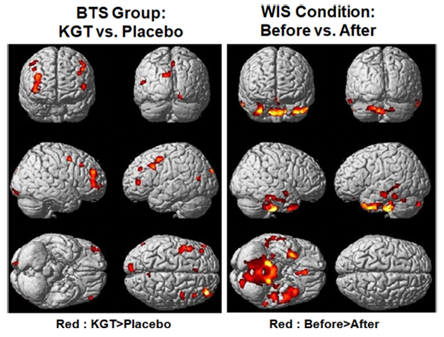글로벌 연구동향
의학물리학
- [J Appl Clin Med Phys.] Treatment evaluation of Kami Guibi-tang on participants with amnestic mild cognitive impairment using magnetic resonance imaging on brain metabolites, gamma-aminobutyric acid, and cerebral blood flow 자기공명영상을 이용한 뇌대사체, 감마아미노부티르산, 뇌혈류에 대한 기억상실 경도인지장애 환자에 대한 카미귀비탕의 치료 평가
경희의대 / 조승연, 장건호*
- 출처
- J Appl Clin Med Phys.
- 등재일
- 2021 Nov
- 저널이슈번호
- 22(11):151-164. doi: 10.1002/acm2.13443. Epub 2021 Oct 11.
- 내용
-
Abstract
Purpose: To evaluate the effectiveness of Kami Guibi-tang (KGT) in the treatment of mild cognitive impairment (MCI) using magnetic resonance imaging (MRI) on brain metabolites, neurotransmitter, and cerebral blood flow (CBF).Methods: We randomly allocated a total of 30 MCI patients to a KGT (N = 16) or a placebo (N = 14) group and performed MRI scans before and after 24 weeks of treatment. The participants underwent brain magnetic resonance spectroscopy and MRI scans to obtain brain metabolites using Point-RESolved Spectroscopy (PRESS) single-voxel spectroscopy, gamma-aminobutyric acid (GABA) neurotransmitter using Mescher-Garwood PRESS, and CBF using pseudocontinuous arterial spin labeling sequences using a 3.0 Tesla MRI system. We analyzed metabolite and neurotransmitter levels and CBF using repeated-measure analysis of variance to evaluate between-subject group effect, within-subject treatment condition effect, and interaction of group by condition (group x condition).
Results: The GABA+/creatine (Cr) ratio values were not significantly different between the before and after treatment conditions. The glutamate complex/Cr ratio difference before and after treatment was lower in the KGT group than in the placebo group, but was not statistically significant (p = 0.077). The result of region of interest-based CBF measurement showed that CBF values were significantly lower after treatment at Cluster 2 for the KGT group (p = 0.003) and the placebo group (p = 0.011), at hippocampus for the KGT group (p = 0.004) and the placebo group (p = 0.008), and at the fusiform gyrus for the KGT group (p = 0.002). Furthermore, the absolute CBF difference before and after treatment in the fusiform gyrus was significantly lower in the KGT group than in the placebo group (p = 0.024).
Conclusions: Although a KGT treatment of 24 weeks showed some significant impact on the level of CBF, the Korean version of the mini-mental state examination score was not significantly different between before and after treatment conditions, indicating that there was no memory function improvement after treatment in amnestic MCI patients. Therefore, further studies should be performed with a relatively larger population and extending the duration of the KGT treatment.

JACMP논문 Figure 3.
복셀기반 뇌혈류(CBF)의 변화를 가미귀비탕(KGT)군과 위약(Placebo)군 간의 차이(Between-subject, BTS)효과와 치료전후 조건(Within-subject, WIS)을 비교한 결과그림이다. 뇌혈류 값이 KGT를 복용한 군에서 더크게나왔으며(왼쪽) 복용후에 뇌혈류값이 낮아지는 것으로(오른쪽) 나왔다.
Affiliations
Seung-Yeon Cho 1 , Sharonkyuhee Kwon 2 , Hee-Yeon Shin 3 , Ha-Ri Kim 3 , Jeong-Hwa Kim 3 , Soonchan Park 4 , Chang-Woo Ryu 4 , Jung-Mi Park 1 , Richard A E Edden 5 , Geon-Ho Jahng 4
1 Stroke and Neurological Disorders Center, Kyung Hee University Hospital at Gangdong, College of Korean Medicine, Kyung Hee University, Seoul, Republic of Korea.
2 Department of Biomedical Engineering, Undergraduate School, College of Electronics and Information, Kyung Hee University, Yongin-si, Gyeonggi-do, Republic of Korea.
3 Department of Clinical Korean Medicine, Graduate School, Kyung Hee University, Seoul, Republic of Korea.
4 Department of Radiology, Kyung Hee University Hospital at Gangdong, College of Medicine, Kyung Hee University, Seoul, Republic of Korea.
5 Division of Neuroradiology, Department of Radiology, The Johns Hopkins University School of Medicine, Baltimore, Maryland, USA.
- 키워드
- Kami Guibi-tang (KGT); brain metabolite; cerebral blood flow; mild cognitive impairment.
- 연구소개
- 경도인지기능장애(MCI) 환자는 정상인지 노인과 알츠하이머병 치매 환자의 중간에 위치하는 인지기능장애 환자로 매년 약 15%의 경도인지기능장애 환자가 알츠하이머병 치매 환자로 전환되는 것으로 알려져 있다. 알츠하이머병 치매 단계에서는 치료를 할 수 있는 약이 없으므로 조기치료를 하는 것이 매우 중요하다. 가미귀비탕(KGT)은 현재 한방에서 건망증, 불면증, 식욕부진 치료에 사용되고 있다. 가미귀비탕이 기억력 개선에 도움이 된다는 동물실험결과를 바탕으로 한국보건산업진흥원의 연구비를 받아 가미귀비탕(KGT)이 경도인지장애 환자의 인지기능 개선에 효과가 있는가를 평가하는 연구를 진행했다. 이 논문은 자기공명영상장치를 이용하여 경도인지장애 환자 30명을(KGT 그룹 N=16, 위약 그룹 N=14명) 대상으로 가미귀비탕 혹은 위약을 복용 전후로 자기공명분광법(MRS)을 이용한 뇌 대사물질과 가바(GABA) 신경전달물질의 변화를 평가하였고 또한 비침습적 뇌혈류 영상법(pCASL)을 이용하여 정량화된 뇌혈류(CBF)의 변화를 평가하였다. 24주 복용전후 뇌대사물질과 가바의 변화는 없었으나 뇌혈류가 가미귀비탕 복용 이후 현저하게 감소되는 것을 확인하였다. 비록 대상자 수가 적고 또한 가미귀비탕을 짧은 기간 복용하여 큰 효과를 보지는 못했으나 뇌혈류량의 변화를 보여준 것이 흥미로웠다고 생각된다. 이 연구결과를 기반으로 강동경희대병원 한방내과에서 임상3상을 진행하는 연구과제로 선정되어 대규모의 임상실험이 진행될 것이며 기억력 변화를 평가하는 뇌기능 자기공명영상법을 이용하여 가미귀비탕 복용 전후 뇌 기능의 향상을 평가할 예정이다.
- 덧글달기










편집위원2
이 논문은 자기공명영상(MRI)를 이용하여 가미귀비탕(KGT)이 경도인지장애 환자의 인지기능과 기억력 향상에 미치는 영향을 평가하는 논문이다. 경도인지장애 환자 30명(KGT 그룹 N=16, 위약 그룹 N=14명)을 대상으로 자기공명분광법(MRS)을 이용한 뇌 대사물질과 가바(GABA) 신경전달물질, 비침습적 뇌혈류 영상법(pCASL)을 이용하여 정량화된 뇌혈류(CBF)의 변화를 평가하였다. 24주 복용전후 뇌 대사물질과 가바의 변화는 없었으나 뇌혈류가 가미귀비탕 복용 이후 현저하게 감소되는 것을 확인되어 한의학분야 연구 개발에서도 MRI의 이용 및 활용은 더욱 증대할 것으로 기대된다.
2022-01-10 16:50:23